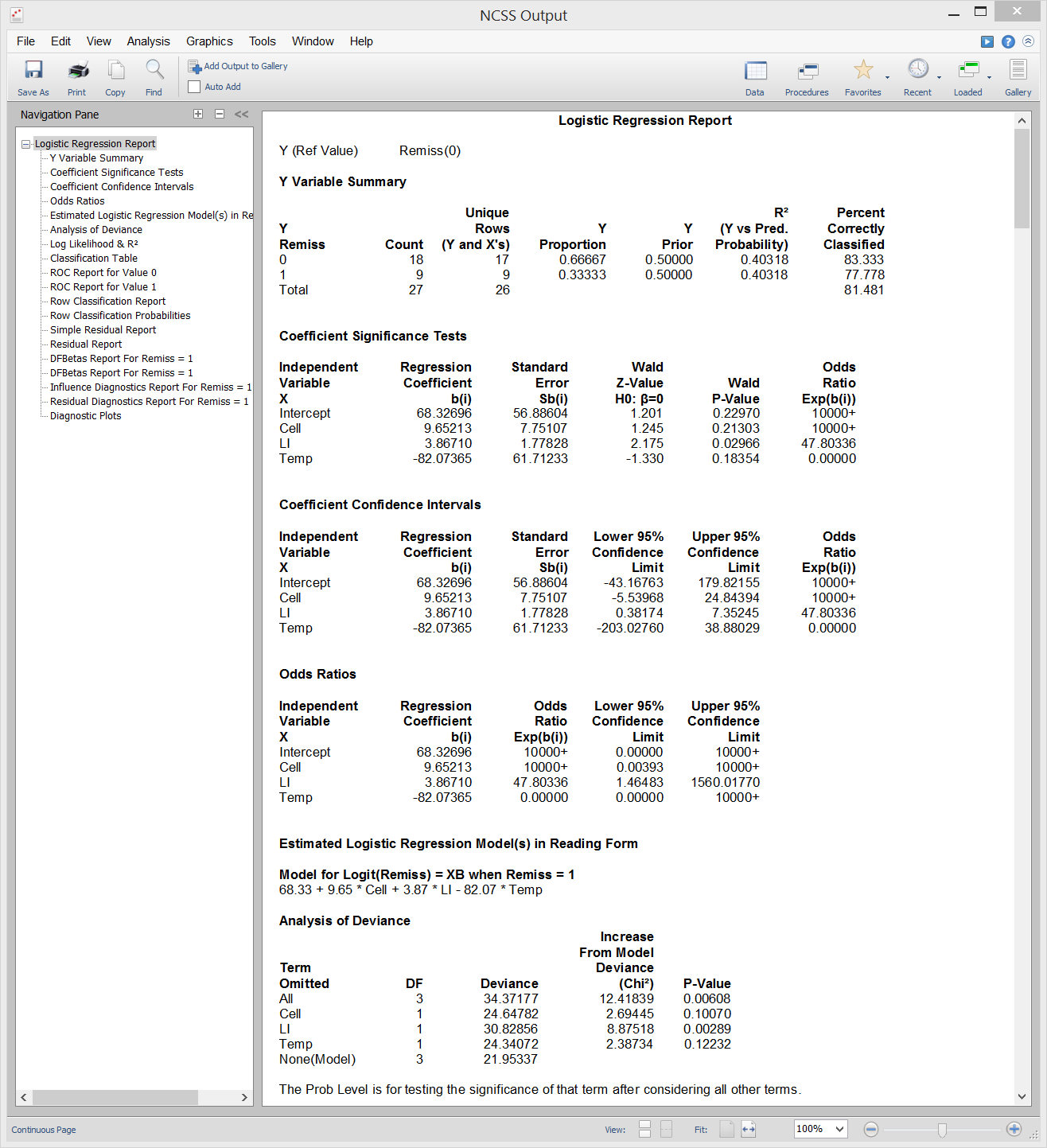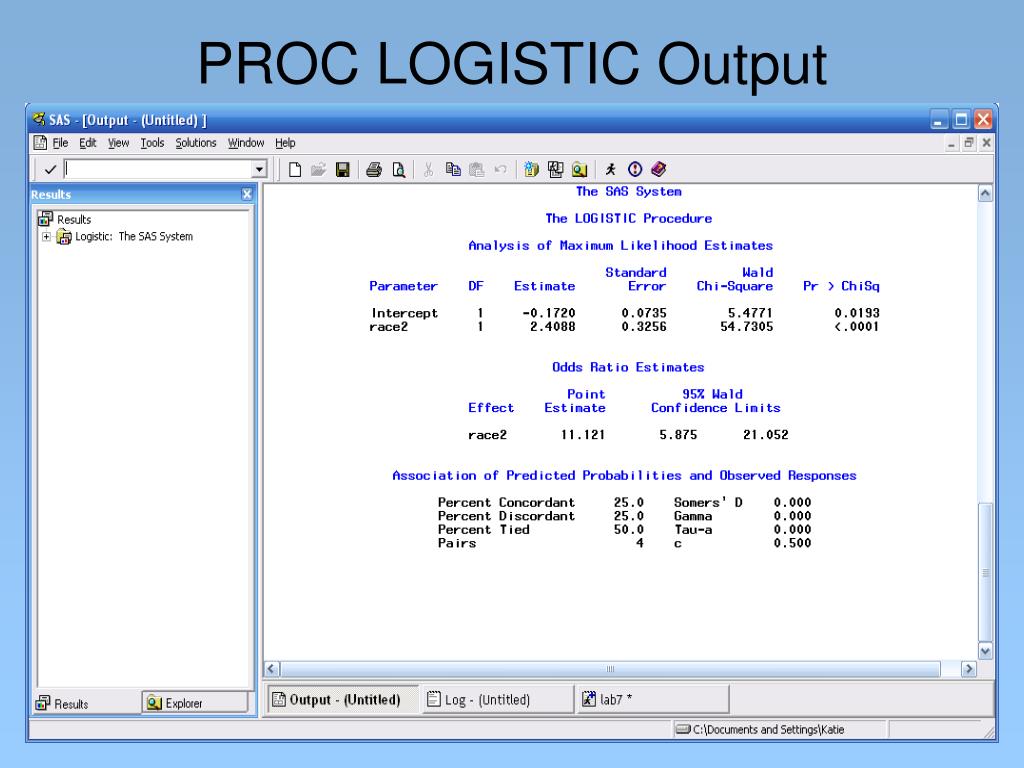Proc logistic output out options
The Statistical Analysis System SAS offers: Consequently, it was possible to manipulate and manage data prior to an analysis without writing several different programs to get data into the proper format for SPSS. SAS also can produce tables that are manuscript ready. A SAS beginner, however, pays for the flexibility by confronting such a large series of options and operations that it appears almost impossible to learn.
This is meant as an introduction to highlight the most important commands useful for those interested in using SAS more for number crunching than for fancy report writing. For the most part, the statements included herein will get you through SAS with no problem. It is suggested that you go over this to become familiar with the SAS statements that will be most useful for you, and then consult SAS manuals for further information about these statements.
SAS statements may be in upper or lower case and may begin on any column. SAS statements may also extend across lines, and more than one SAS statement may appear on a single line. SAS statements always end with a semicolon. Thus, the following set of statements are all equivalent: There are two general steps in SAS.
The first is the DATA step in which data are read in, manipulated, edited, etc. The second is the PROC or procedure step in which some statistical procedure e. Any number of DATA and PROC steps can occur in a single program. For example, one can read a set of data in the first DATA step, perform a regression PROC REG that outputs predicted values and standardized residuals to the data, use a second DATA step to remove outliers, do another PROC REG without the outliers, and merge the full data set with an exiting SAS data file in a third DATA step.
The two steps are discussed in turn. There are 4 basic uses of the SAS DATA step: Each is discussed below: Getting data into a SAS data set: Including the data in the SAS command stream. In this sense the data are like a card deck placed into the stream of SAS commands. Use an INPUT command to list the variables and a CARDS statement right before the data to be read in. DATA CARDSIN; INPUT IDNUM SEX AGE; CARDS; 1 1 25 2 2 33 4 1 Read the data in from a disk file. Here one uses the INFILE command to name the disk area with the data and the INPUT command to list the variables.
DATA DISKIN; INFILE 'RAWDATA. DAT'; INPUT IDNUM SEX AGE. Create a new data set from an existing SAS data set. Here, the SET command is used to name the existing SAS data set. The following example creates two new SAS data sets from an existing SAS data set: There are three forms of the INPUT statement used for reading in raw data: Just list the variables. On the raw data file, each case must start on a separate record and each variable must be separated by at least one space.
For example, INPUT IDNUM SEX AGE. The input statement lists the variable and its inclusive column numbers. For example, INPUT IDNUM SEX AGE. This lists the variables in parentheses, then the format, also in parentheses. For example, INPUT IDNUM SEX AGE 4. SAS does not distinguish between integers and real numbers. It treats all variables as real. Thus the following FORTRAN statement and the two SAS formats are equivalent: READ 1, ' I2,F8. INPUT ITEM SCORE X SEX 2.
For example, you can read one proc logistic output out options from columns on the first record, read the second variable from columns of the fourth record, go back to best paypal forex brokers 2016 first record and read columnsetc.
In SAS formatted input, the format list is processed only until the number of variables in the variable list. The following formats may NOT be equivalent: READ 1,' I2, F8.
Manipulating data SAS is a very rich language for data manipulation. The most useful commands are given here. See the SAS manual for their syntax.

ARRAY Works like a DIMENSION statement in Fortran. DELETE Deletes the observation from a data set. IF SEX NE 'MALE' AND SEX NE 'FEMALE' THEN DELETE. END Works like a do loop in fortran. IF SEX NE 'MALE' AND SEX NE 'FEMALE' THEN DO; PUT 'VALUE OF SEX IN ERROR FOR ID NUMBER' ID; DELETE; RETURN; END. GO TO Stock market trading for beginners books a GOTO in BASIC or FORTRAN, but SAS statements are given name labels that end with a colon.
PUT 'ID NUMBER' ID 'IS AN OUTLIER. RETURN This is analogous but not identical to a subroutine call. Processing returns to the SAS statement after the LINK statement.
Becareful about the RETURN statement. A RETURN statement that is not part of a LINK series begins processing of a new observation. A RETURN statement after a Clubs open on anzac day melbourne returns to the next statement following its call.
PUT Equivalent of WRITE or PRINT in Fortran. If a FILE statement is used, the output goes to the named file; otherwise, it goes to the print file. The PUT statement has the same 3 syntax forms as the INPUT statement: DAT'; PUT ID SEX AGE 4. Data Management SAS data sets can exist only for the duration of a single job or they can be stored on a more permanent basis like an SPSS system file. Permanent SAS data sets are very easy to manipulate, update, etc.
But when a SAS data set is stock option stock split made permanent or later updated, it is a good idea to manage the data to reduce storage costs. The following statements are useful in this regard:.
Currency in toronto trader jobs Drop the variables cien market report stockholm the data set. Useful for variables only used for temporary programming convenience. DROP I J TEST1-TEST5 ABX--XXY.
LENGTH Sets the storage size for variables. If you are creating or analyzing large SAS data sets, then it is highly recommended that make money free nichel length statement be stock markets closed good friday for integer type data because all SAS variables default to real variable type storage and thus take up more room.
The following statement sets the Minnesota Multiphasic Personality Inventory items to three bytes of storage each: Data creation The SAS DATA step can also be used for general programming when no "real" data are used. SAS has a wide variety of built in functions that can Monte Carlo data or generate a statistic that is hard to calculate by hand. See the SAS manual for the functions. The PROC step calls up a Proc logistic output out options procedure.
Some SAS procedures are for data management, others are for statistical analysis. SAS can convert SPSS, BMD-P, OSIRIS and other data sets into SAS format with a one line command. It can call up a BMDP program to analyze data in a SAS data set. It will even draw you a map of the wine growing regions of Portugal, if you so desire. Only the basic PROCs are listed here. SAS often has several PROCs for most types of analyses; one is a general purpose PROC, the others are more efficient subtypes.
PROC steps may also produce specialized data sets that can be input into other SAS procedures e. Data Management Procedures PROC SORT Sorts a data set by one or more variables. PROC SORT; BY ID; will sort the data set by the values of the variable ID. PROC CONTENTS Displays the contents of the data set.
PROC DATASETS Manages SAS data set libraries. PROC RANK Rank orders one or more variables. PROC SCORE Generates linear scores for certain procedures like factor analysis and discriminant analysis. PROC TRANSPOSE Transposes a data set. Low Resolution Graphics PROC CHART Pie, bar, and star charts.
PROC PLOT Two dimensional plots. Descriptive Statistics PROC FREQ Simple frequencies and contingency tables for categorical variables.
PROC MEANS Number of observations, mean, standard deviation, and minimum and maximum values for continuous variables. PROC SUMMARY Descriptive statistics broken down by groups; particularly useful for generating a data set of descriptive statistics for input into other procedures.
PROC CORR Parametric and nonparametric correlations. Regression Procedures PROC REG General purpose linear regression and multivariate regression. PROC RSQUARE All possible subsets of regression. PROC RSREG Quadratic response surface regression. PROC LOGISTIC Logistic regression. PROC PROBIT Probit regression. Analysis of Variance Procedures PROC ANOVA Analysis of variance for orthogonal data. PROC NESTED Nested analysis of variance. PROC VARCOMP Variance components.
Discriminant Procedures PROC DISCRIM General purpose parametric and nonparametric discriminant analysis.

PROC CANDISC Canonical discriminant analysis. Principal Components and Factor Analysis Procedures PROC PRINCOMP Principal components. PROC FACTOR Factor analysis.
Logistic Regression for Rare Events | Statistical Horizons
Survival Analysis PROC LIFETEST Nonparametric and life tables. PROC LIFEREG Parametric survival analysis. Cluster Analysis PROC CLUSTER Clustering observations.
PROC FASTCLUS Disjoint clustering for large data sets. PROC VARCLUS Clustering variables. To illustrate the utility of the SAS data step used in conjunction with various SAS procedures, consider the problem of getting the correlation matrices for a multivariate twin analysis of the National Merit Twin data on the National Merit test.
SAS is used to "double enter" the twins, creating an intraclass matrix.
Four ways to create a design matrix in SAS - The DO Loop
The data are then sorted by sex and zygosity, the correlation matrices are calculated, and output to a raw data file so that model fitting can be done.
SAS can also efficiently do model fitting with IML, but that is too advanced for our purposes here. Finally, other MZ and DZ matrices are computed by pooling males with females and output. Sorts a data set by one or more variables. Generates linear scores for certain procedures like factor analysis and discriminant analysis. Simple frequencies and contingency tables for categorical variables. Number of observations, mean, standard deviation, and minimum and maximum values for continuous variables.
More detailed descriptive statistics for continuous variables. Descriptive statistics broken down by groups; particularly useful for generating a data set of descriptive statistics for input into other procedures. General purpose linear regression and multivariate regression.
General purpose parametric and nonparametric discriminant analysis. Principal Components and Factor Analysis Procedures.
